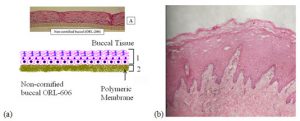Buccal Drug Delivery
The buccal region of the mouth has been widely explored for the delivery of drugs and nutraceuticals. It is known that the content of non-polar lipids, ceramides and glycosylceramides (lipids forming majority of the permeation barrier) is lower in buccal membrane compared to skin which makes it a better target than transdermal route. When compared to the traditional oral route of administration, the buccal route of delivery offers distinct advantages such as avoiding first pass metabolism and pre-systemic elimination of chemical compounds within the GI tract. This is useful for compounds which have been shown to undergo extensive degradation by microorganisms in the gut and enzymes in the liver especially compounds with toxic metabolic by-products produced as a result of hepatic metabolism.
The LDD specializes in studying the permeation of different chemicals of pharmaceutical (e.g. nicotine, naltrexone) and nutraceutical (e.g. quercetin, tyrosine) importance across buccal membranes. The models used include both tissue engineered membranes available commercially (e.g. MatTek’s Corp. ORL 606) and ex vivo porcine buccal mucosa. The studies include the permeation analysis (flux, lag time, permeation coefficient, etc.) of compounds and their formulations, analysis of the tissues using sectioning, staining and immunohistochemistry analysis. The group also conducts studies to systematically evaluate the role of permeation enhancers and retardants compounds with chemicals of interest.
Funding Source: NIH R43 DA025351-01 “Oral transmucosal drug delivery system for nicotine” and NIH R43 AA018894-01 “Oral transmucosal drug delivery system for naltrexone for alcohol dependence treatment”.
